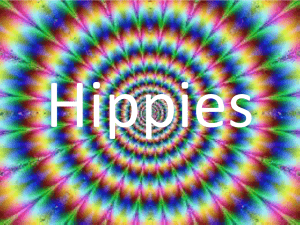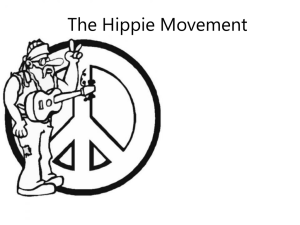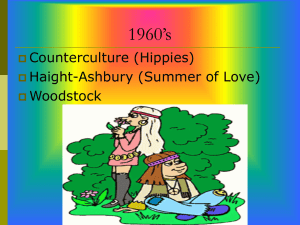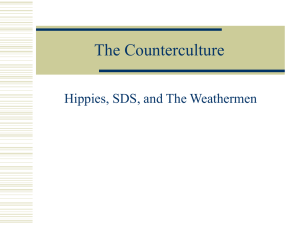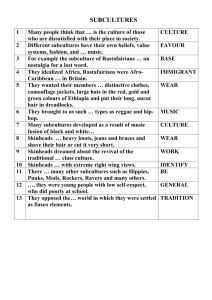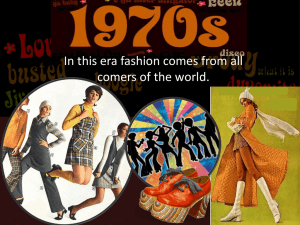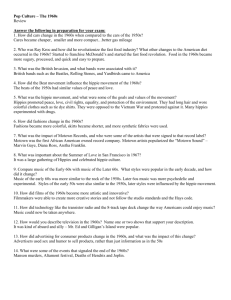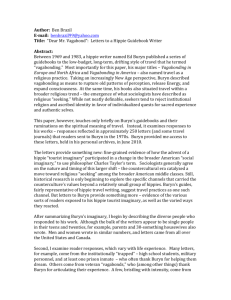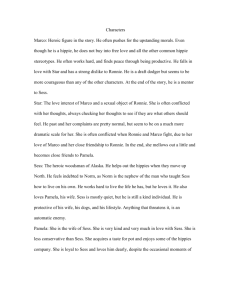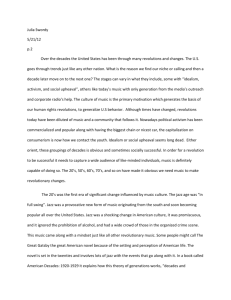2. Ancestor of the Hippie Movement
advertisement
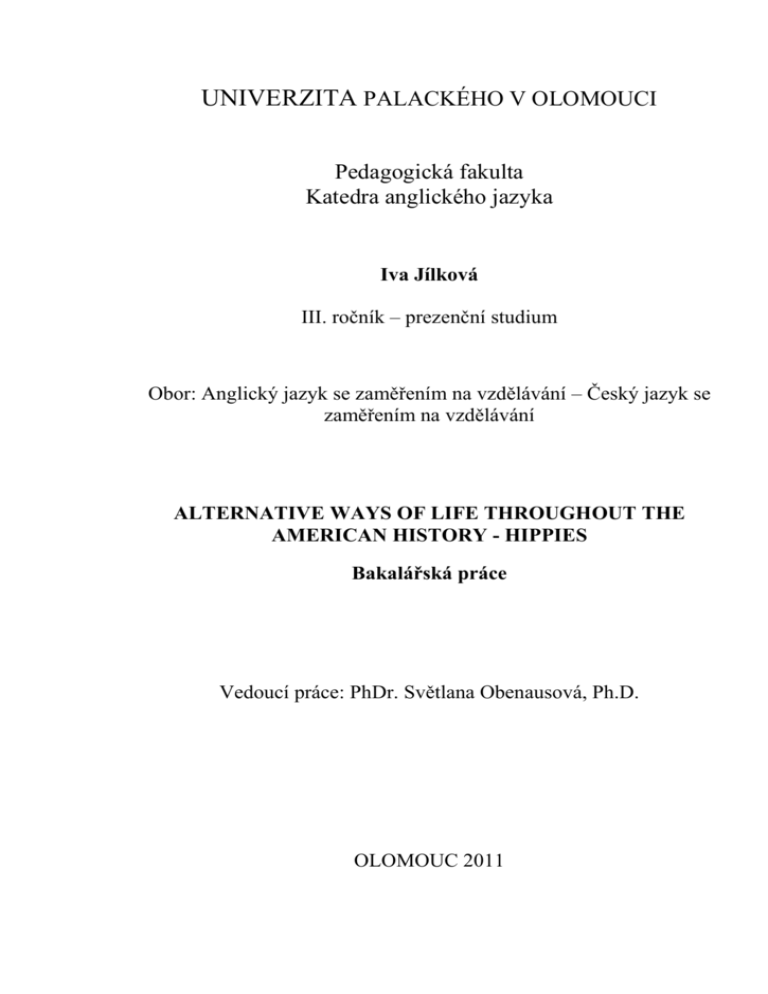
UNIVERZITA PALACKÉHO V OLOMOUCI Pedagogická fakulta Katedra anglického jazyka Iva Jílková III. ročník – prezenční studium Obor: Anglický jazyk se zaměřením na vzdělávání – Český jazyk se zaměřením na vzdělávání ALTERNATIVE WAYS OF LIFE THROUGHOUT THE AMERICAN HISTORY - HIPPIES Bakalářská práce Vedoucí práce: PhDr. Světlana Obenausová, Ph.D. OLOMOUC 2011 Prohlašuji, že jsem bakalářskou práci vypracovala samostatně a použila jen uvedených pramenů a literatury. Souhlasím s uveřejněním této práce V Olomouci: 27. 6. 2011 ………………………………. vlastnoruční podpis 2 I would like to thank PhDr. Světlana Obenausová, Ph.D. for her valuable comments and inspiration. I would also like to thank my uncle for his comments on the content of my bachelor project. 3 TABLE OF CONTENTS ACKNOWLEDGEMENTS ABSTRACT INTRODUCTION........................................................................................................................ 7 1. Subculture................................................................................................................................ 8 2. Ancestor of the Hippie Movement........................................................................................... 9 2.1. The Beat Generation.................................................................................................. 9 2.2. Hippies and Beatniks................................................................................................ 10 3. Etymology................................................................................................................................ 12 4. Who Were the Hippies? .......................................................................................................... 13 5. Why Did the Hippie Movement Appear? ............................................................................... 15 6. Life of the Hippies................................................................................................................... 16 6.1. Philosophy.................................................................................................................. 16 6.2. Travelling.................................................................................................................. 17 6.3. The Hippie Trail........................................................................................................ 18 7. Appearance of Hippies............................................................................................................. 19 8. Drugs........................................................................................................................................ 20 8.1. Using Drugs............................................................................................................... 20 8.1.1. Deaths caused by using drugs.................................................................... 22 8.2. Timothy Leary.......................................................................................................... 22 8.3. The Shamans............................................................................................................. 23 9. Music........................................................................................................................................ 25 9.1. Influence of Hippies.................................................................................................. 25 9.2. Summer of Love....................................................................................................... 26 4 9.3. Woodstock Festival................................................................................................... 26 10. Religion.................................................................................................................................. 28 11. Politics................................................................................................................................... 29 11.1. The Vietnam War.................................................................................................... 29 11.1.1. Protest Movements................................................................................... 30 11.2. The Peace Symbol................................................................................................... 31 12. Descendants of the Hippie Movement................................................................................... 32 12.1. The Yippies............................................................................................................. 32 12.2. The Neo-hippies...................................................................................................... 32 13. Hippies in Czechoslovakia..................................................................................................... 34 15. End of the Hippie Movement................................................................................................. 36 CONCLUSION............................................................................................................................ 37 BIBLIOGRAPHY........................................................................................................................ 38 RÉSUMÉ ANNOTATION 5 ABSTRACT Many alternative ways of life appeared throughout the American history. My bachelor thesis is focused on one of them – the hippie movement. The word “hippie” was developing from the 1930’s till its first usage in newspapers in 1965. According to Oxford Advanced Learner’s Dictionary, “hippie” is “a person who rejects the way that most people live in Western society, often having long hair, wearing brightly coloured clothes and taking illegal drugs.” 6 Introduction In my opinion, there are so many people who know almost nothing about the hippie movement. I was one of them so I have decided to go through this theme and find some detailed information about this movement. Firstly, I explain the term “subculture” because the hippie movement was a part of subculture in the United States. When speaking about hippies I should also explain what the origin of the word “hippie” is. I focus on the life of hippies. Travelling was very important for them as it was a way how to meet new people and also get drugs. Hippies led a bohemian life, started to listen to a new style of music and they chose a new style of appearance which people who were not a part of the hippie movement did not accept. I further mention the ancestors of hippies and also the descendants, hippies in Czechoslovakia and the end of the hippie movement. The final goal of my work is to get more detailed information about the hippie movement and its background. The found information might be used in teaching practice when teaching about the history of the United States and when speaking about the alternative ways of life during lessons. 7 1. Subculture Firstly, I should explain what the word “subculture” means, because the hippie movement, as well as beatniks 1 , Provos 2 , teddy boys, mods, rockers 3 and many others belonged to subcultures (Pospíšil, Blažek, 2010). According to Oxford Advanced Learner’s Dictionary subculture is “the behaviour and beliefs of a particular group of people in society that are different from those of most people”. As Pospíšil and Blažek explain, the expression “subculture” started to develop in the American society after the Second World War. According to Marshall, people in a subculture were solving problems together and helping each other. We can say that subcultures try to be the opposite of cultures. Being a part of a subculture was an escape from everyday life full of restrictions. Many people who were considered as different from the rest of the society, such as homosexuals, found their acceptance in subcultures (Marshall, 2011). As Pospíšil and Blažek write, to find out reactions of the other members of the subculture, so called “exploratory gestures” are a part of creating new subcultures. The members of subcultures agree on the gestures that became group norms. However, these group norms usually raised the oppositions from the main society which, on the other hand, increased the cooperation between people inside the subculture. People in subcultures usually choose their appearance and behaviour in the way to provoke the society (Pospíšil, Blažek, 2010). 1 A group of American writers who led a bohemian life. Subculture in the Netherlands; the members opposed capitalism, communism and the military. 3 Teddy boys, mods and rockers were subcultures in Great Britain whose fashion also influenced Czechoslovakian hippies. 2 8 2. Ancestor of the Hippie Movement 2.1. The Beat Generation At the beginning, I would mention the ancestor of the hippie movement which is considered to be the Beat Generation. This is the reason why I would like to highlight some facts about this group of American writers. As Parkins writes, the Beatniks appeared in the 1950’s. They were writers who wanted also ordinary people to understand their poetry. Their poetry was influenced by jazz which means their poems are rhythmical, similar to songs. Beatniks were interested in ecology and they were against middle-class and military (Parkins, 2005). As described by Jankowski, Beatniks had long hair and beard and wore jeans. Their clothes were dirty as they did not wash it and they usually did not wear shoes. Beatniks liked alcohol, refused materialism and did not acknowledge Christianity (Jankowski, 1975). Pospíšil and Blažek say that their choice of colours for their clothes and other equipment was provoking. The colours were khaki and dark green because much of their stuff came from army sales (Pospíšil, Blažek, 2010). According to Pospíšil and Blažek, society classed them together with hooligans as they could not see that Beatniks were intelligent young people with some beliefs. Beatniks did not work and travelled a lot. They gathered in public places in city centres, begged, and used marijuana (Pospíšil, Blažek, 2010). Beatniks did not respect either the values of their parents or firm ways of behaviour or life perspectives. They wanted to have new experiences but they also had to face unfriendly reactions from the rest of society (Pospíšil, Blažek, 2010). According to Parkins, the Beatniks had great influence on musicians such as Bob Dylan, the Beatles or Jefferson Airplane. Allen Ginsberg, Jack Kerouac, William Burroughs and Gary Snyder were the most influential (Parkins, 2005). 9 Allen Ginsberg is considered to be the main representative of the Beat generation and also one of the most celebrated writers in America. As Hampton points out, Howl is his most significant poem where he celebrates homosexuality and drug use and calls for freedom of speech. When this protesting poem was published, it had many opponents. Another well-known Ginsberg’s poem is called Kaddish (Hampton, 2011). Among other notable writers of the Beat generation and their works belong: Jack Kerouac and his novel On the Road and William Burrough with his Naked Lunch that together with Ginsberg’s Howl were the keys to liberalization of publishing in the United States (Hampton, 2011). 2.2. Hippies and Beatniks We can say that the hippie movement developed from the Beat generation. These two subcultures had much in common but they also differed in many ways. Firstly, the things hippies and Beatniks had in common should be mentioned. According to Nugent, one of the things they had in common was drug use. They were both youth movements that experimented with them. Both hippies and Beatniks believed in eastern religion. Another common feature was their rebellious and bohemian life which led to the fact that the rest of the American society did not accept them as a part of their society (Nugent, 2007). Secondly, I would like to mention differences between these two movements. As Woods writes, the Beat generation was a group of writers who wrote poetry and songs as a form of expression. They wore clothes of dark colours, goatees and berets, while hippies started to wear colourful clothes and long hair and protested more. Another difference between hippies and Beatniks was that Beatniks gathered in coffee shops, but hippies started to meet in the streets (Woods, 2010). 10 As Jankowski points out, the difference was also in their music. Hippie music differed from that of the beatniks in a rhythm which was difficult to listen to and stay sitting. In the period of Beatniks, people at concerts were all sitting. With the coming of the hippies and the new style of music all the people started to dance along with the members of the bands (Jankowski, 1975). 11 3. Etymology Now, I would like to explain what the origin of the word “hippie” is. There are many opinions how the word “hippie” originated. I mention some of them. Jankowski mentions that the original word “hippie” developed from “hepcat”, which originally appeared in the 1930’s and was used as a label for the metropolitan bohemians who liked jazz and swing music. The expression “hep” changed to “hip” in the 1950’s. To be “hip” was a term used to describe the members of society who had reached the life wisdom and were capable of critical thinking. These people were full of love of life and other people (Jankowski, 1975). As Jankowski says, the term “hip” was first used by Beatniks and had a positive meaning; however, later it gained a negative meaning which led to creating a new name by members of the hippie movement: Free Man. This denotation, though, was never used (Jankowski, 1975). On the other hand, some say that the word “hippie” developed from the jargon word “hipster” that was used from the 1940’s. It is believed that this term developed from the word “hop” which means opium, or from the word “hipi” which means in West African language “to open one’s eyes” (Difference Betveen Hippie and Hipster, 2011). The word “hippie” was first used on television at the opening of the New York World Fair in 1964 where some young protesters, wearing denim jeans and long hair, were called “hippies” by the reporters. The first use of this term in newspapers appeared in San Francisco on the 6th September, 1965, where young bohemians were described as “hippies” (Hippie: Encyclopedia II – Hippie – Origins, 2011). 12 4. Who Were the Hippies? Hollis et al. state that the hippie movement was a movement of young people aged 15 – 25 that appeared in San Francisco around 1960. From here it spread worldwide through rock and psychedelic music, literature, art and fashion. However, it had its biggest influence in the USA (Hollis et al., 2011). As Jankowski (1975) mentions, most of the hippies came from the upper-middle class which means that their families were wealthy; the majority of hippies lived in California or in New York. Truman writes why the youngsters in the 1960’s joined the hippie movement. According to him the young people were looking for fun and freedom which they found when joining the hippie movement. Moreover, hippies fought for racial, gender and social equality what the young Americans admired (Truman, 2007). Jankowski writes that many hippies finished secondary school and about half of them were university-educated. Their language was very rich. It was a mixture of literary language from their homes, schools and universities with black people’s slang and professional jargon. They also took over the language of beatniks (Jankowski, 1975). According to Hollis et al., hippies differed from their parents in many ways. Their adults were hard-working to have enough money, but the hippies were the opposite of them. The only thing they wanted was to enjoy life to the full (Hollis et al., 2011). Truman adds that drugs were on the first place for hippies, followed by sex, music and peace. Most of the members of the hippie movement did not work or went to church (Truman, 2007). I would say this is not the positive side of the hippie movement. Most of the people would have family and health on the first place, and unemployment would be unimaginable for them. 13 As Jensen mentions, hippies fought against the things they did not like. They used drugs, wore different styles of clothing, wanted sexual liberation and listened to new music. These are the reasons why many American people did not accept them as a part of their society (Jensen, 2011). „They wanted peace, and believed in peaceful way of solving conflicts with solutionmethods like dialogue, co-operation and negotiation.” (Jensen, 2011) Hippies wanted to be themselves and to live in a safe society “…with all living human beings and animals living together in harmony. “ (Jensen, 2005) In Jankowski’s (1975) opinion, it is often difficult to find out some facts about the history of hippies as they had nobody to write it down, and to record some situations in such an unstable environment is not easy either, though some information can be found in the judicial chronicles. As Jankowski writes, the official birth of the hippie movement is considered to be the 14th of January 1967, the date when The World’s First Human Be-in took place in the Golden Gate Park in San Francisco. This was the first world gathering of people. People were dressed in costumes, dancing, eating, using drugs and listening to their prophets for the first time. The most well known prophet was Timothy Leary (Jankowski, 1975). The hippie movement had no leaders and was not planned at all; hippies did not discuss anything and did not vote, though all the participants of the movement sometimes met at festivals (Jankowski, 1975). 14 5. Why Did the Hippie Movement Appear? Jankowski mentions two reasons why the hippie movement appeared: 1. External causes with roots in political, social and economical conditions lay outside the individuals, even though they influenced the individual’s behaviour. 2. Internal causes represented changes in the psyche of young Americans. These were most often changes in their attitude towards society. Jankowski points out that it was observed that many young people from the middle classes in America were interested not only in the situation within their class but also the situation in the lower classes, and wanted to remove the differences between them. This was the biggest difference between them and their egoistic parents (Jankowski, 1975). According to Jankowski, young Americans were afraid of the war in Vietnam, possible civil war between black and white people, crime or total destruction from the atom bomb. These were the reasons why they decided to join the hippie movement (Jankowski, 1975). Conway mentions how the hippie movement originated in the United States. He writes that the hippie movement developed from the German group of young people called “Wandervogel“. They lived in communes and rejected the established institutions. They moved to the United States at the beginning of the 1900’s and influenced the youngsters there (Conway, 2011). 15 6. Life of the Hippies 6.1. Philosophy Members of the hippie movement led different life than the majority of society in the USA. Their life was not only adventurous but also dangerous and their influence on the society was more negative than positive. As Conway describes the ideology of the hippie movement, we can learn that hippies refused everything what was established and tried to be the opposite to the rest of the society. They refused nuclear weapons and wanted to create a world full of peace and love (Conway, 2011). Moreover, as Williams (2011) writes, hippies rejected authority and wanted sexual liberation which meant having more partners and living with each other before wedding. To express their feelings, protests and their imagination of the world and life, as Conway mentions, the hippies used alternative arts, street performance and folk music. Hippies were usually vegetarians and environmentally friendly (Conway, 2011). The hippie movement was very influential. Williams gives examples how this movement influenced the culture in the United States. The movement influenced music the most. Several bands were inspired by the hippie imagination of peace and love. Besides music hippies influenced also art, film and television (Williams, 2011). According to Stone, hippies did not force others to believe in the same things they did; they wanted to change the world by what they believed in. They believed that “the way to peace is through love and tolerance. Loving means accepting others as they are, giving them freedom to express themselves and not judging them based on appearances.”(Stone, 2011) Stone shows us what freedom means for the hippies. Freedom is the ability of everybody to do what they want, go wherever they want and gain new experiences. We can consider this the purpose of the hippie philosophy (Stone, 2011). 16 Stone points out other features of a hippie philosophy. These were a belief in Gaia (which means the earth as an organism), the Green movement and shamanism. Hippies were respecting nature and the whole planet and refused materialism (Stone, 2011). As Lindaur writes, hippies lived a bohemian life. They wanted to be free, not bounded by anything. This meant that they were against government and power and did not respect rules (Lindaur, 1999). 6.2. Travelling Hippies travelled a lot. They travelled often in big groups and in old school buses or Volkswagen vans because this kind of travelling was cheap for them. Their buses were usually decorated with graphics and symbols, mostly symbols of peace. Many young Americans preferred hitchhiking because it was economical, environmentally friendly and they met a lot of new people with the same ideas (Hippie, 2011). Hippies travelled light and they never planned their journey in advance. They did not mind when and where they would go. They packed only a few necessary things and travelled anywhere. Most of the time, they did not know where their journey would end, where they would sleep or whether they had money or not. However, this was their kind of travelling (Hippie, 2011). As Davis mentions, when speaking about the kind of hippie travelling we cannot forget to mention the hippie’s most favourite vehicle for travelling. It was a Volkswagen bus which was “…designed to be mechanically simple and reliable such that anyone with a basic set of tools could learn to be his own Volkswagen mechanic. This design philosophy fit well into the hippie philosophy of primitive subsistence, which was the necessary result of the hippie’s rejection of the division of labour.“ (Davis, 2000) 17 Hippies liked the mobility of the Volkswagen buses which also served them as a kind of a mobile apartment when they were travelling for long distances (Davis, 2000). 6.3. The Hippie Trail As Gregory (2011) describes, The Hippie Trail was a route from Istanbul to India travelled by many hippies and other youngsters, either in search of spiritual enlightenment or profit, wanting to escape from a life full of convenience, or just wanting to see the world. Gregory explains that these journeys were made since the 1950’s but the hippies gave it the name “The Hippie Trail” in the 1960’s. The Hippie Trail led to the world’s major hashish producing centres. The first destination on the Hippie Trail was Afghanistan because hippies were welcomed here and a huge number of people used hashish here. Manali was another great marijuana destination (Gregory, 2011). Gregory points out that hippies sometimes stayed in winter at the beaches of Goa where they could have gained hashish freely. On the other hand, they spent summer in Nepal, where hashish was also sold legally (Gregory, 2011). As Gregory (2011) mentions, the Hippie Trail came to an end in 1979 when the overland route was closed for the westerners by Islamic revolution in Iran and the Russian invasion of Afghanistan. I think the Hippie Trail shows us how hippies found drugs important. They travelled many kilometres for many days to get drugs legally. This is a great example of the way of the hippie life. Hippies did not live on one place but they travelled most of the time and drugs were the most important for them. They would go anywhere to get drugs. 18 7. Appearance of Hippies The hippies chose a new way of dressing and appearance which made them look different from the rest of the society at first sight. It was their purpose to be distinguished from the people who were not supporters of the hippie movement. As Jankowski writes, the hippies, living close to black people, accepted some of their styles of dress and appearance. They began to wear clothes of violent colours with many accessories made of metal, glass and leather and also a new style of haircut called an “afro“ (Jankowski, 1975). As Powellová and Peelová point out, members of the hippie movement brought the freedom into the dressing style; all types of clothes, lengths and patterns were allowed. They favoured natural materials for making their clothes and refused uniformity. There were almost no differences between men and women because both men and women wore long hair and even the same clothes. The only difference was in size (Powellová, Peelová, 1998). According to Jensen, hippies only wore clothes which were comfortable for them and their clothes were usually bigger than they needed them. The most favourite colours of their clothes were: pink, yellow and green. They wore dark round sunglasses and often decorated their clothes with real flowers which they also put in their hair (Jensen, 2011). Jensen writes: “The hygiene was not very high-priority among the hippies. It could be weeks between each shower and the flowers they used to decorate their hair and clothes spread dirt everywhere they went.“ (Jensen, 2011) Because of wearing flowers on their clothes and in their hair hippies were also called “flower children” and their movement was called “flower power” (Jensen, 2011). Tie-dying clothes and bell-bottoms were very popular at hippies and people wearing suits were funny for them (Truman, 2007). 19 In my opinion, fashion of the hippie movement had a great influence on society. Mainly because from this time people could decide on their own what they wanted to wear or even if they wanted to be naked. As Powellová and Peelová claim, till the 1960’s people had to wear clothes according to some rules. Casual clothes differed from the formal clothing, some kinds of fabrics were used only for the evening dress and the other kinds were used for casual clothes. In the 1960’s these habits changed. People started to wear the same clothes for the whole day and even the fabrics were used for various kinds of clothes (Powellová, Peelová, 1998) 20 8. Drugs 8.1. Using drugs Using drugs was very popular between hippies; however, it had negative effects on their lives. Because of drug use many people died and many famous musicians were between them. As Truman writes, hippie’s drug use affected the most youngsters in America. From this time, more young people started to be drug addicted (Truman, 2007). At the beginning, when the hippie movement first appeared, the sale of certain drugs was still legal in the USA. This raised the possibilities of getting drugs easily (Lindaur, 1999). As Stone puts it, after World War II drugs were used to prevent and cure diseases, to reduce pain, to help people with sleeping problems, even to reduce children’s hyperactivity. Drugs were seen as a miracle of modern technology and people believed that drugs could cure all diseases. There were no fears that drugs could be dangerous. The only exception was heroin because it was addictive (Stone, 2011). Hippies used mostly LSD and marijuana because they wanted to discover the effects they could cause (Lindaur, 1999). Experimenting with drugs in the 1960’s, especially by hippies, is considered to be the largest in the human’s history (Jensen, 2011). Shlain and Lee explain why the youngsters in America started to experiment with drugs. They used drugs because the drugs enabled them to see the world in different eyes, experience new feelings, adventures and excitement (Shlain, Lee, 1996). Experimenting with drugs led to disunion of young people and the older generation but, on the other hand, it brought them nearer to people of the same age who had the same experiences with using drugs (Shlain, Lee, 1996). “By the end of the Hippie Movement, San Francisco's local government was paying over $35,000 a month for drug abuse treatment for the city's 10,000 hippies. “ (Saville, 2010) 21 8.1.1. Deaths caused by using drugs As written above there were many people who died because of drug abuse in the 1960’s. This was one of the negative sides of the hippie movement. I would like to mention some musicians who died of drugs overdose. As Conway writes Jimi Hendrix was one of those who succumbed to drug using. Janis Joplin became alcohol and drug addicted which led also to his death. The death of Jim Morrison was caused by use of heroin which resulted in heart attack. The other musicians who died of drugs overdose were: Keith Moon, Brian Jones or Jerry Garcia (Conway, 2011). I think the facts mentioned above show us how drugs are dangerous and people should be aware of this fact and try to avoid meeting with drugs of any kind because they can cause people’s death. 8.2. Timothy Leary When talking about drugs in the 1960’s I cannot forget to mention Harvard University professor Timothy Leary. As Jankowski describes, Timothy Leary was born in 1920. Till the year 1960 he was teaching at Harvard University. In 1960 he first tried mushrooms with psychedelic effects. This inspired him to further experimenting with drugs (Jankowski, 1975). As Hanák mentions, Leary tested the drugs on himself, colleagues and many volunteers. The amount of his followers was growing and he started experimenting with other psychedelic drugs such as marijuana, peyote, mescaline and LSD 25 (Hanák, 1992). According to Jankowski, Leary’s intention was to find a medicine for development of the human race. However, his experiments on volunteers had negative effects on them and after two years of experimenting he was dismissed from the University (Jankowski, 1975). 22 As Jankowski writes, Leary continued to give lectures on drugs to broad audiences. He thought that the number of Americans using LSD would increase up to 10 to 30 million people by the year 1970. His estimation, luckily, did not realize. Leary’s motto was: “Turn on, tune in, drop out!” which meant: “Join the movement, join what is happening here, cast school and office away.” (Jankowski, 1975) 8.3. The Shamans According to Stone, in the hippie movement there were some shamans who experimented with drugs, firstly on themselves then, after they reported their experiments, on the others in the movement. They were called Psychedelic Shamans (Stone, 2011). Stone mentions the main shamans in the hippie movement. As Stone writes, Timothy Leary was considered to be the King of Shamans. He encouraged artists, scientists and even clergymen to experiment with LSD. Richard Nixon called him “the most dangerous man in America“ (Stone, 2011). For Stone, Aldous Huxley was also one of the main shamans, experimenting with LSD and mescaline. He wrote a novel called “Brave New World” about a consumerist society, and their choice of drugs. His another book called “Doors of Perception of Heaven and Hell“ is based on his own experience with mescaline. He described how drugs “open the doors” of the mind. The rock group “The Doors” was inspired by this book and used part of its title when naming their band (Stone, 2011). Stone speaks about John Lennon as another personality linked with Psychedelic Shamans. His charisma and talent had a great influence on youngsters. He changed view of the world after experimenting with drugs and became more inventive and experimental in composing his songs. His songs inspired great numbers of young people who followed him in experimenting with drugs. He wanted a world based on peace and love (Stone, 2011). 23 As Stone remarks, Jim Morrison was considered as a shaman as well. Morrison was a poet, philosopher, songwriter and lead singer of the music band “The Doors”. His opinion was that drugs were “Doors” to other worlds and his music brought people to dark places of their minds (Stone, 2011). The last shaman I would like to mention is Ken Kesey. As Stone states, Kesey together with a group of people formed around him called The Merry Pranksters saw psychedelic drugs as a new way of enjoying the life. They made a psychedelic trip across the country which inspired many people to follow them (Stone, 2011). 24 9. Music 9.1. Influence of hippies As Hollis at al. states, music together with drugs was also very important in the life of hippies. Music was for them the way how to express their thoughts (Hollis et al., 2011). As Saville writes, many hippies were musicians who wrote music to express their feelings, beliefs and ideas. “They held many concerts in numerous places, where they came together to drink, smoke, sing, make love, dance, be together, and just be hippies. “ (Saville, 2010) According to Truman, hippies changed not only style of the music but also the lyrics of the songs. The musicians inspired by hippies used themes like drugs, violence or sex in their songs and their influence remained till these days (Truman, 2007). As Hollis et al. point out, Bob Dylan had the biggest influence. For instance his song called “Like a Rolling Stone” expresses both the thoughts of himself and also of the hippies. What the hippies liked the most about Bob Dylan was a simple text that had a kind of sense (Hollis et al., 2011). As Hollis et al. write, drugs were another popular theme for many musicians. The theme of LSD appears in the song “Lucy in the Sky with Diamonds” sung by The Beatles. The song “Casey Jones” from The Grateful Dead is about cocaine and the guitarist Jimmy Hendrix was singing about marijuana in his song “Purple Haze”. Hippies started to listen to the style of music called Rock Roll which was developing together with them (Hollis et al., 2011). 25 9.2. Summer of Love “Summer 1967 in Haight-Ashbury became known as the "Summer of Love" as young people gathered (75,000 by police estimates) and shared the new culture of music, drugs, and rebellion.“ (Hippie: Encyclopedia II – Hippie – Origins, 2011). McCulloch says that for people, when they hear about the Summer of Love, psychedelic music comes to mind. Psychedelic music was a mix of blues, folk music and Indian influences (McCulloch, 2007). According to McCulloch, the use of drugs, mostly cannabis and LSD, was another characteristic feature of the Summer of Love. The hippies defended the use of cannabis as natural because it is a plant and the usage of LSD as a way to be amazed by the wonders of nature (McCulloch, 2007). 9.3. Woodstock Festival As Šebestová writes, the Woodstock festival was the biggest ever gathering of hippies. The festival took place from the 15th to 18th August in Bethel, New York. It was not only a music festival but also a peaceful demonstration. The posters said that this festival would mean three days of peace and music (Šebestová, 2010). In Šebestová’s opinion, the people who gathered in Woodstock wanted to show their peaceful attitudes and protested against violence. It was a great opportunity for hippies to show their opposition to the Vietnam War. About 500,000 hippies came to this festival. At the beginning, tickets were sold but so many people arrived that organizers annulled the entrance fee and people could go inside for free (Šebestová, 2010). The festival started on Friday the 15th at 5 o’clock in the evening by singer Richie Havens. More than 30 musicians appeared during the festival, among others, The Grateful Dead, 26 Jefferson Airplane, The Who, and Carlos Santana. The festival was brought to the end on Monday the 18th in the morning by Jimi Hendrix (Woodstock – květinové děti, marihuana, trip a LSD, 2009). As Šebestová mentions, despite bad weather during the festival, lack of food, and not enough comfort for people the festival was successful. However, many people living in the neighbourhood complained because of the noise, mess and the traffic-jam caused by the visitors of the festival (Šebestová, 2010). The festival was, however, sad in some ways: two young men died of drugs overdose and a 17-year old boy was run-over by a tractor. On the other hand, two babies were born at the Festival (Woodstock – květinové děti, marihuana, trip a LSD, 2009). 27 10. Religion Members of the hippie movement believed in different religions, often refusing religion of the mainstream society. There were several kinds of hippies who believed in different religions such as Buddhism or Hinduism; many of them travelled from Europe to India where they stayed and studied these religions (Answers, 2011). Another group of hippies came from the United States where they were brought by psychedelic music together with drugs. Some of them also believed in the eastern religions and some in Native spirituality. Hippies who were in touch with nature practiced the Wicca religion, a kind of a modern witchcraft (Answers, 2011). Hippies were looking for something new even in the sphere of religion, so they “…went to look in the already established religions all around the world and together they created a movement that is called New-Age…“ (Answers, 2011) New-Age is a mixture of philosophies from different religions such as ecology, pacifism and humanism (Answers, 2011). 28 11. Politics 11.1. The Vietnam War The hippies were against all wars, but the war in Vietnam was the one which hippies were protesting against. Because of this, I think it is important to say something about this war. As Kamas writes, the Vietnam War broke out in 1955. The war was fought between the communist North Vietnam (that finally won in 1975), and the anti-communist South Vietnam. China and the Soviet Union were helping North Vietnam and the USA was on the side of anticommunists (Kamas, 1997). As Gilcher-Holteyová states, the Congress gave way to the American president to fight in the area of south-west Asia “without limitation” which led to deploying of 460,300 young American soldiers in Vietnam. This military interference evoked disagreement around the whole world (Gilcher-Holteyová, 2004). As Simkin points out, at the beginning of the war in Vietnam, there were not many Americans who were against it. People who did not want to be involved “...in Vietnam fell into three broad categories: people with left-wing political opinions who wanted an NLF victory; pacifists who opposed all wars; and liberals who believed that the best way of stopping the spread of communism was by encouraging democratic, rather than authoritarian governments.“ (Simkin, 2011) However, as Simkin writes, as the war broke out the American people started to protest against use of chemical weapons against the Vietnamese. Finally, the USA was blamed for using chemical weapons that were banned and also for torturing innocent people (Simkin, 2011). According to Gilcher-Holteyová, the American President Lyndon Johnson was asked to stop the war on the 30th December, 1964. The suggestion, though, was not supported by enough votes. Because of this, “The march on Washington” which expressed disapproval with the USA 29 military interference in Vietnam was organized. 15,000 – 20,000 demonstrators took part in this march (Gilcher-Holteyová, 2004). 11.1.1. Protest Movements Demonstrations against the Vietnam War occurred for the first time on the 16th October 1965 in forty American cities followed by demonstrations in European cities like London or Rome. The protests continued. 35,000 anti-war protesters gathered in Washington on the 27th November 1965. The protesters circled the White House and then marched on Washington (The Vietnam War, 2011). Other anti-war protests appeared on the 26th March 1966 in New York, Washington, Chicago, Philadelphia, Boston and San Francisco. An advertisement against the war signed by 6400 teachers and professors even appeared in the New York Times on the 4th June 1966. Another great march of 55,000 protesters, called “March on Pentagon”, occurred on the 21st – 23rd October 1967 (The Vietnam War, 2011). The most brutal attack of police on the anti-war protesters happened on the 28th August 1968 in Chicago, when 10,000 protesters gathered in the streets. 800 protesters were injured during this attack (The Vietnam War, 2011). As Simkin mentions, not only white young people protested against the Vietnam War but there were also black people among the protesters. The poor blacks were annoyed with the war because it cost a lot of money and America invested money into the war instead of helping poor people to get out of poverty. Another reason why they protested against the war was the fact that mostly poor people were sent to fight in Vietnam (Simkin, 2011). 30 11.2. The Peace Symbol As most of the groups and movements also the hippie movement had its symbol which expressed their ideology. The symbol of the hippie movement was the peace symbol. The peace symbol was created by the British artist Gerald Holtom in 1958 as a symbol for the Direct Action Committee Against Nuclear War which was an anti-nuclear organization (Rosenberg, 2011). As Rosenberg writes, it is a circle with three lines inside representing two semaphore letters – “N” and ”D” which stand for “nuclear disarmament”. Semaphore is a system using flags to delivering messages over long distances, such as from ship to ship (Rosenberg, 2011). According to Rosenberg, the letter “N“ is formed when holding a flag in each hand and pointing them to the ground at a 45 degree angle. The letter “D” is formed also with holding two flags: one flag is pointed straight up and the second one is pointed straight down (Rosenberg, 2011). Jensen (2011) adds that the symbol represents two Christian symbols – the earth and God’s hand inside. According to Kolsbun, peace is the most important for people. The peace symbol was a symbol of well behaving to all living creatures, both people and animals, and it also symbolised world without fighting (Kolsbun, 2011). The peace symbol became well know all around the world and it is still used by peace activists today (Rosenberg, 2011). 31 12. Descendants of the Hippie Movement 12.1. The Yippies As the hippie movement had its ancestors, it also had its descendants which were called the Yippies. According to Figueroa, the Yippies, Youth International Party, was a left wing movement that developed from the hippie movement in 1967. The founders of this movement were Abbie Hoffman and Jerry Rubin (Figueroa, 2011). As Pollick remarks, the Yippies were more radicalized than the hippies, however, their ideas of manifestations were really absurd. “They believed that street violence was the only means of changing government and civil organizations.“ (Figueroa, 2011). Pollick explains that the Yippies did not succeed in their goals but they caught the attention of the media which was also their intention. Nevertheless, their illegal demonstrations usually clashed with police brutality when many of the Yippies were injured and arrested. The Yippie movement became increasingly wide-spread throughout the 1970’s (Pollick, 2011). As Forte points out, the Yippies wanted a free society full of love, money was not important for them. They also wanted other people to be part of social change, such as the end of the Vietnam War and racism (Forte, 1999). 12.2. The Neo-hippies The neo-hippies were descendants of the original hippies who had similar beliefs as them (The History of Hippies, 2011). This name was given to the young people of the 21st century who still believed in the philosophy of the hippie movement Hippie: Encyclopedia II – Hippie – Hippy, 2011). 32 Neo-hippies, like hippies, wanted a world of peace and justice which meant that anti-war demonstrations continued. They were vegetarians and believed in animal rights (Hippie: Encyclopedia II – Hippie – Hippy, 2011). Drug use was not as popular at neo-hippies as at hippies. Drugs were not important for their life. Those who refused drugs used alternative methods of recreation such as community singing, meditation, dance or yoga (The History of Hippies, 2011). The neo-hippie movement changed into the “Green Movement” which included environmentalism, non-violence and social justice. They supported ecology, environment and peace movements (The History of Hippies, 2010). 33 13. Hippies in Czechoslovakia The hippie movement also appeared in Czechoslovakia in the mid 1960’s. According to Kuča, in Czechoslovakia, though, supporters of this movement were not called hippies but “máničky” or “vlasatci” (because they had long hair) or “hašišáci” (people who were using drugs). The movement in Czechoslovakia was in many ways influenced by the hippies in America, but it also differed in some ways (Kuča, 2000). As Kuča points out, the birth of many rock bands and the gathering of youngsters in the communities was one of the common features between the hippies in Czechoslovakia and United States. The Czechoslovakian hippies gathered on the steps in front of the National Museum in Prague. Rebel parades through Prague where members of the parade clashed with the police happened very often because people were protesting against the communist regime (Kuča, 2000). Kuča mentions that hippies in Czechoslovakia were also heavily influenced by the poetry of the beat generation – mainly by the poetry of Ginsberg and Ferlingetti. This is seen on the visit of Ginsberg in Prague in 1965 which caused an increase in the number of Czechoslovakian hippies. To celebrate his visit “Majáles” (a parade of people in masks) was organised, which had been forbidden before, and Ginsberg was chosen as the King of “Majáles”. The whole of this parade, however, became something as a demonstration against the communist government (Kuča, 2000). As Kuča describes, the communists decided that they would stop this movement, so the members of the unofficial parade were imprisoned on the 1st May, 1966. After that, an edict against hooligans (as hippies in Czechoslovakia were also called), was published. This edict meant not only cutting the hair of those who were caught; it also forbade them from entering public buildings such as restaurants, cinemas or stations. This all was justified as preventing the spread of parasites (Kuča, 2000). 34 According to Kuča, this was not the right way to get rid of the hippies. Another rebel parade, which proclaimed: “Give us our hair back!” and “Away with barbers!” took place on the 23rd September, 1966. Again, the members were imprisoned. Several other rebel gatherings took place after that and finally, in 1967, the communist government withdrew (Kuča, 2000). As Kuča writes, following political liberalization in 1968, hippies with the official name “Czechoslovakia Hippies Club Soul” appeared along with many other associations. This movement was very different from the hippies in the USA, mainly due to the fact that they rejected bad habits such as drug use or committing crimes. They wanted to work and respected the law (Kuča, 2000). As Kuča remarks, this association only lasted to the year 1969 when the period of normalization started. The movement was broken up by the police and finally this hippie movement disappeared in full, meaning the end of the hippie movement in Czechoslovakia (Kuča, 2000). As Pospíšil and Blažek state, the one big advantage which the hippies in the USA had was that they could publish their books and music, and organize concerts and festivals. The Police and the State did not have the power to forbid any of this to them. There was no law that they had to work while people who did not work in Czechoslovakia were arrested (Pospíšil, Blažek, 2010). 35 14. End of the Hippie Movement As Hrabalík puts it, there were several reasons why the hippie movement ended. First of all, hippies were not able to create unifying and strong philosophical context which meant that several different groups existed which stayed sometimes even against each other. The drug use was also one of the reasons that brought the hippie movement to the end (Hrabalík, 2011). Secondly, as Hrabalík writes, the murderer Charles Manson and the Manson Family with their behaviour and especially their committing murders changed the attitude of the rest of the society to the hippie movement a lot. Manson and his Family were pretending they were hippies as well, however, they were racists and criminals and the rest of the society thought that all the hippies were the same (Hrabalík, 2011). Another reason why the hippie movement was brought to the end was a violent attempt from extremists to turn the members of the hippie movement to the left oriented politics (Hrabalík, 2011). 36 Conclusion The goal of my work was to find some detailed information about the hippie movement. I have found out much new information about the hippie movement and its background. The hippie movement was very rebellious. Hippies rejected established institutions and militarism; they used drugs in great amounts and led a bohemian life. The hippie movement was close to the Beat generation which appeared in the 1950’s. Hippies were active in anti-war demonstrations. The hippies also appeared in Czechoslovakia. However, the communist regime tried to get rid of them by cutting their hair and putting them in prison. The hippie movement ended because of the acting of Charles Manson and the use of cocaine which started destroying their lives. Members of the hippie movement were very influential, both in bad and good ways. I think I could use some of the facts written in my bachelor project in my teaching practise in the future when introducing who the hippies were to the students. 37 Bibliography BOOKS: BLAŽEK, P.; POSPÍŠIL, F. „Vraťte nám vlasy!“: první máničky, vlasatci a hippies v komunistickém Československu. Praha: Academia, 2010. 589 s. ISBN 978-80-200-1873-1. FORTE, B. Timothy Leary: Pohled z onoho světa. Praha: Volvox Globator, 2001. 295 s. ISBN 80-7207-393-1. GILCHER-HOLTEYOVÁ, I. Hnutí "68 na Západě: studentské bouře v USA a západní Evropě. Praha: Vyšehrad, 2004. 143 s. ISBN 80-7021-698-0. HANÁK, O. Hippies: Slepé rameno mrtvé řeky. Praha: Argo, 1992. 135 s. ISBN 80-901198-4-0. HORNBY, A. S. Oxford Advanced learner’s Dictionary, 2010. Oxford: Oxford University Press 2010. 1732 s. ISBN: 978-0-19-4799126. JANKOWSKI, K. Odvrácená tvář Ameriky: Hippie hledají zaslíbenou zemi. Praha: Orbis, 1975. 224 s. ISBN: neuvedeno. KAMAS, D. Válka ve Vietnamu: (1964 – 1975). Olomouc: Votobia, 1997. 263 s. ISBN 80-7198247-4. LEE, M. A.; SHLAIN, B. Sny vědomí: CIA, LSD a revolta šedesátých let. Praha: Volvox Globator, 1996. 293 s. ISBN 80-7207-018-5. 38 LINDAUR, V. Šance sněhových koulí v pekle. Praha: Maťa, 1999. 124 s. ISBN 80-86013-73-1. PEELOVÁ L.; POWELLOVÁ P. Styly 50. a 60. let. Praha: Václav Svojtka & Co., 1998. 128 s. ISBN 80-7237-018-9. 39 ONLINE SOURCES: CONWAY, T. L. What Happened to the Hippies? [online]. c2011 [cit. 2011-06-09]. Available from: http://hubpages.com/hub/What-Happened-to-the-Hippies. DAVIS, G. Why Hippies Loved the VW Bug [online]. April 27, 2000. [cit. 2011-03-20]. Available from: http://mises.org/daily/417. Difference Between Hippie and Hipster [online]. c2011 [cit. 2011-06-09]. Avalable from: http://www.differencebetween.net/miscellaneous/difference-between-hippie-and-hipster/. FIGUEROA, L. A. Yippies [online]. Last updated on 11 May 2000. [cit. 2011-03-10]. Available from: http://www.trincoll.edu/classes/hist300/yippies.htm. GREGORY, R. A Brief History of the Hippie Trail [online]. [cit. 2011-03-25]. Available from: http://www.richardgregory.org.uk/history/hippie-trail.htm. HAMPTON, W. Allen Ginsberg, Master Poet Of Beat Generation, Dies at 70 [online]. c2010 [cit. 2011-06-21]. Available from: http://www.nytimes.com/learning/general/onthisday/bday/0603.html. Hippie: Encyclopedia II – Hippie – Hippy [online]. [cit. 2011-02-27]. Available from: http://www.experiencefestival.com/a/Hippie_-_Hippy/id/1292464. 40 Hippie: Encyclopedia II – Hippie – Origins [online]. [cit. 2011-02-27]. Available from: http://www.experiencefestival.com/a/Hippie_-_Origins/id/1292459. Hippie. Wikipedia, the free encyclopedia [online]. Last modif. on 15 June 2011. [cit. 2011-0213]. Available from: http://en.wikipedia.org/wiki/Hippies. HOLLIS et al. The Hippie Generation [online]. [cit. 2011-02-16]. Available from: http://users.rowan.edu/~lindman/hippieintro.html. HRABALÍK, P. Hippies - Sebevražedná koncovka [online]. c1996-2011 [cit. 2011-05-26]. Available from: http://www.ceskatelevize.cz/specialy/bigbit/folk-rock/clanky/38-hippiessebevrazedna-koncovka/. JENSEN, R. The age of hippies and the term “flower power” [online]. c2004-2011 [cit. 201102-22]. Available from: http://www.daria.no/skole/?tekst=4523. KOLSBUN, K. Peace: The Biography of a Symbol [online]. c2011 [cit.2011-06-17]. Available from: http://www.peacesymbol.com/. KUČA, P. Dlouhovlasá kronika [online]. c2000 [cit. 2011-02-15]. Available from: http://ld.johanesville.net/historie/05-dlouhovlasa-kronika. MARSHALL, G. Subculture. A Dictionary of Sociology [online]. [cit. 2011-06-16]. Available from: http://www.encyclopedia.com/doc/1O88-subculture.html. 41 McCULLOH, A. The 1967 Summer of Love [online]. April 12, 2007. [cit. 2011-03-25]. Available from: http://www.suite101.com/content/the-1967-summer-of-love-a18598. NUGENT, W. Beatniks, Hippies and the 1967 Summer of Love! [online]. c2005-2011, posted on 11 October 2007. [cit. 2011-05-26]. Available from: http://www.articlesbase.com/religionarticles/beatniks-hippies-and-the-1967-summer-of-love-232371.html. PARKINS, K. Beat Generation [online]. [cit. 2011-06-20]. Available from: http://www.heureka.clara.net/art/beat-generation.htm. POLLICK, M. Who Were the Yippies? [online]. c2003-2011 [cit. 2011-03-10]. Available from: http://www.wisegeek.com/who-were-the-yippies.htm. ROSENBERG, J. 1958 – Peace Symbol Created [online]. c2011 [cit. 2011-03-18]. Available from: http://history1900s.about.com/od/1950s/qt/peacesymbol.htm. SAVILLE, R. The Hippie Movement of the 1960s [online]. September 25, 2010. [cit. 2011-0325]. Available from: http://www.suite101.com/content/the-hippie-movement-of-the-1960s- a289998. STONE, S. Hippies from A to Z. [online]. c1999 [cit. 2011-02-10]. Available from: http://www.hipplanet.com/books/atoz/atoz.htm. 42 ŠEBESTOVÁ. D. Woodstock 1969: Květinový víkend, na který se nezapomíná [online]. July 20, 2010. c2009-2011 [cit. 2011-03-27]. Available from: http://www.topzine.cz/woodstock-1969kvetinovy-vikend-na-ktery-se-nezapomina/. The Vietnam War [online]. c1999 [cit. 2011-05-27]. Available from: Available from: http://www.historyplace.com/unitedstates/vietnam/index-1965.html. The History of Hippies [online]. [cit. 2011-02-10]. http://www.happyhippie.com/hippie-history.html. TRUMAN, N. The hippie subculture [online]. c2002-2011, created on: August 27, 2007 [cit. 2011-06-13]. Available from: http://www.helium.com/items/558651-the-hippie-subculture. What religion do hippies believe in? [online]. c2011 [cit. 2011-03-12]. Available from: http://wiki.answers.com/Q/What_religion_do_hippies_believe_in. WILLIAMS, L. The Effects of the Hippie Movement [online]. c1999-2011 [cit. 2011-06-09]. Available from: http://www.ehow.com/info_8340728_effects-hippie-movement.html. WOODS, T. Before Hippies There Were Beatniks [online]. January 11, 2010. [cit. 2011-05-26]. Available from: http://tucsoncitizen.com/retroflections/2010/01/11/before-hippies-there-werebeatniks/. 43 Woodstock – květinové děti, marihuana, trip a LSD [online]. August 15, 2009. [cit. 2011-03-27]. Available from: http://www.ct24.cz/o-cem-se-mluvi/63597-woodstock-kvetinove-detimarihuana-trip-a-lsd/. 44 RÉSUMÉ Závěrečná práce je zaměřena na hnutí hippies jako alternativní způsob života v průběhu americké historie, které se objevilo v 60. letech 20. století v San Franciscu a odtud se rozšířilo do celého světa. Informace byly získávány studiem tištěných a internetových zdrojů. Byl zjištěn způsob života, jaký vedli členové této komunity a byl porovnán s životem Beatniků, kteří jsou považováni za předchůdce hnutí hippies. Dále byli zmíněny demonstrace proti válce ve Vietnamu a filozofie hnutí. 45 ANOTACE Jméno a příjmení: Iva Jílková Katedra nebo ústav: Katedra anglického jazyka Vedoucí práce: PhDr. Světlana Obenausová, Ph.D. Rok obhajoby: 2011 Název práce: Alternativní způsoby života v průběhu americké historie – hippies Název v angličtině: Alternative ways of life throughout the American history – hippies Anotace práce: Bakalářská práce se zabývá alternativními způsoby života v průběhu americké historie; konkrétně je zaměřena na hnutí hippies. Pojednává o životě členů hnutí, o jejich předchůdcích i následovnících. Hippies užívali drogy a byli ovlivněni hudbou. Jedná se o subkulturu, která se objevila v 60. letech. Byly zjištěny informace o náboženství, politice, cestování a také postojích k Vietnamské válce. Klíčová slova: Hnutí hippies, generace beatniků, subkultura, drogy, hudba, Vietnamská válka, protesty, hippies v Československu Anotace v angličtině: The bachelor project deals with alternative ways of live throughout the American history; it is concretely focused on the hippie movement. It deals with the life of the members of the movement, their ancestors and descendants. Hippies used drugs and were influenced by music. It is a subculture that appeared in the 1960’s. The information about religion, politics, travelling and also attitudes to the Vietnam War was found. Klíčová slova v angličtině: Hippie movement, Beat generation, subculture, drugs, music, Vietnam war, protests, hippies in Czechoslovakia Rozsah práce: 46 s. Jazyk práce: Angličtina 46
